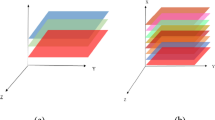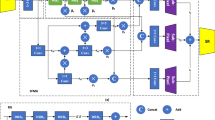Abstract
Hyperspectral image classification (HSIC) is a hot topic discussed by most researchers. In recent years, deep learning and especially CNN have provided very good results in HSIC. However, there is still a need to develop new deep learning-based methods for HSIC. In this study, a new CNN-based method is proposed to reduce the number of trainable parameters and increase HSIC accuracy. The proposed method consists of 3 branches. Squeeze-and-excitation network (SENet) in the first branch, a hybrid method consisting of the combination of 3D CNN and 2D DSC in the second branch, and 2D DSC in the third branch are used. The main purpose of using a multi-branch network structure is to further enrich the features extracted from HSI. SENet used in the first branch are integrated into the proposed method as they increase the classification performance while minimally increasing the total number of parameters. In the second and third branches, hybrid CNN methods consisting of 3D CNN and 2D Depthwise separable convolution were used. With the hybrid CNN, the number of trainable parameters is reduced and the classification performance is increased. In order to analyze the classification performance of the proposed method, applications were carried out on the WHU-Hi-HanChuan, WHU-Hi-LongKou and Indian pines datasets. As a result of the applications, 97.45%, 99.84% and 96.31% overall accuracy values were obtained, respectively. In addition, the proposed method was compared with nine different methods developed in recent years from the literature and it was seen that it obtained the best classification result.

















Similar content being viewed by others
Data availability
Data will be made available on request.
References
Ahmad M, Khan AM, Mazzara M, et al (2020) A Fast and Compact 3-D CNN for Hyperspectral Image Classification. IEEE Geosci Remote Sens Lett 1–5. https://doi.org/10.1109/LGRS.2020.3043710
Ari A, Hanbay D (2018) Bölgesel Evrişimsel Sinir Ağları Tabanlı MR Görüntülerinde Tümör Tespiti. Gazi Üniversitesi Mühendislik-Mimarlık Fakültesi Derg 2018:1395–1408. https://doi.org/10.17341/gazimmfd.460535
Ben Hamida A, Benoit A, Lambert P, Ben Amar C (2018) 3-D deep learning approach for remote sensing image classification. IEEE Trans Geosci Remote Sens 56:4420–4434. https://doi.org/10.1109/TGRS.2018.2818945
Chen Y, Zhang Z, Zhong L (2019) Three-Stream Convolutional Neural Network with Squeeze-and-Excitation Block for Near-Infrared Facial Expression Recognition. Electron 8:385
Cui B, Dong XM, Zhan Q, et al (2022) LiteDepthwiseNet: A Lightweight Network for Hyperspectral Image Classification. IEEE Trans Geosci Remote Sens 60:. https://doi.org/10.1109/TGRS.2021.3062372
Fırat H, Hanbay D (2022) 4CF-Net: New 3D convolutional neural network for spectral spatial classification of hyperspectral remote sensing images. J Fac Eng Archit Gazi Univ 37:439–453. https://doi.org/10.17341/gazimmfd.901291
Fırat H, Hanbay D (2023) Comparison of 3D CNN based deep learning architectures using hyperspectral images. J Fac Eng Archit Gazi Univ 38:521–534. https://doi.org/10.17341/gazimmfd.977688
Fırat H, Asker ME, Hanbay D (2022) Hybrid 3D Convolution and 2D Depthwise Separable Convolution Neural Network for Hyperspectral Image Classification. Balk J Electr Comput Eng 10:35–46. https://doi.org/10.17694/bajece.1039029
Firat H, Asker ME, Bayindir Mİ, Hanbay D (2022a) 3D residual spatial–spectral convolution network for hyperspectral remote sensing image classification. Neural Comput Appl 8:. https://doi.org/10.1007/s00521-022-07933-8
Fırat H, Asker ME, Ilyas M, Hanbay D (2022a) Spatial-spectral classification of hyperspectral remote sensing images using 3D CNN based LeNet-5 architecture. Infrared Phys Technol 127:. https://doi.org/10.1016/j.infrared.2022.104470
Firat H, Asker ME, Hanbay D (2022b) Classification of hyperspectral remote sensing images using different dimension reduction methods with 3D/2D CNN. Remote Sens Appl Soc Environ 100694. https://doi.org/10.1016/j.rsase.2022.100694
Fırat H, Emin M, Mehmet A, et al (2022b) Hybrid 3D / 2D Complete Inception Module and Convolutional Neural Network for Hyperspectral Remote Sensing Image Classification. Neural Process Lett 1–44. https://doi.org/10.1007/s11063-022-10929-z
Gao H, Yang Y, Li C et al (2021) Multiscale Residual Network with Mixed Depthwise Convolution for Hyperspectral Image Classification. IEEE Trans Geosci Remote Sens 59:3396–3408. https://doi.org/10.1109/TGRS.2020.3008286
Gong H, Li Q, Li C, et al (2021) Multiscale Information Fusion for Hyperspectral Image Classification Based on Hybrid 2D-3D CNN. Remote Sens 13:. https://doi.org/10.3390/rs13122268
Han Y, Wei C, Zhou R, et al (2020) Combining 3D-CNN and Squeeze-and-Excitation Networks for Remote Sensing Sea Ice Image Classification. Math Probl Eng 2020:. https://doi.org/10.1155/2020/8065396
Hu J, Shen L, Sun G (2018) Squeeze-and-Excitation Networks. Proc IEEE Comput Soc Conf Comput Vis Pattern Recognit 7132–7141. https://doi.org/10.1109/CVPR.2018.00745
Iyer P, Lal ASS (2021) Deep learning ensemble method for classification of satellite hyperspectral images. Remote Sens Appl Soc Environ 23:100580. https://doi.org/10.1016/j.rsase.2021.100580
Jamali A, Mahdianpari M, Mohammadimanesh F, Homayouni S (2022) A deep learning framework based on generative adversarial networks and vision transformer for complex wetland classification using limited training samples. Int J Appl Earth Obs Geoinf 115:103095. https://doi.org/10.1016/j.jag.2022.103095
Kumar V, Singh RS, Dua Y (2022) Morphologically dilated convolutional neural network for hyperspectral image classification. Signal Process Image Commun 101:116549. https://doi.org/10.1016/j.image.2021.116549
Li H, Zeng N, Wu P, Clawson K (2022) Cov-Net: A computer-aided diagnosis method for recognizing COVID-19 from chest X-ray images via machine vision. Expert Syst Appl 207:118029. https://doi.org/10.1016/j.eswa.2022.118029
Li Z, Wen B, Luo Y et al (2022b) Hyperspectral image classification based on octave convolution and multi-scale feature fusion. Precis Eng 75:80–94. https://doi.org/10.1016/j.precisioneng.2022.01.005
Li Y, Zhang H, Shen Q (2017) Spectral-spatial classification of hyperspectral imagery with 3D convolutional neural network. Remote Sens 9:. https://doi.org/10.3390/rs9010067
Lin Z, Ji K, Leng X, Kuang G (2019) Squeeze and Excitation Rank Faster R-CNN for Ship Detection in SAR Images. IEEE Geosci Remote Sens Lett 16:751–755. https://doi.org/10.1109/LGRS.2018.2882551
Luo W, Zhang C, Li Y et al (2022) Deeply-supervised pseudo learning with small class-imbalanced samples for hyperspectral image classification. Int J Appl Earth Obs Geoinf 112:102949. https://doi.org/10.1016/j.jag.2022.102949
Makantasis K, Karantzalos K, Doulamis A, Doulamis N (2015) Deep supervised learning for hyperspectral data classification through convolutional neural networks. Int Geosci Remote Sens Symp 2015-Novem:4959–4962. https://doi.org/10.1109/IGARSS.2015.7326945
Pande S, Banerjee B (2022) HyperLoopNet: Hyperspectral image classification using multiscale self-looping convolutional networks. ISPRS J Photogramm Remote Sens 183:422–438. https://doi.org/10.1016/j.isprsjprs.2021.11.021
Peng J, Zhou Y, Chen CLP (2015) Region-Kernel-Based Support Vector Machines for Hyperspectral Image Classification. IEEE Trans Geosci Remote Sens 53:4810–4824. https://doi.org/10.1109/TGRS.2015.2410991
Rajendran T, Valsalan P, Amutharaj J, et al (2022) Hyperspectral Image Classification Model Using Squeeze and Excitation Network with Deep Learning. Comput Intell Neurosci 2022:. https://doi.org/10.1155/2022/9430779
Roy SK, Chatterjee S, Bhattacharyya S et al (2020a) Lightweight Spectral-Spatial Squeeze-and- Excitation Residual Bag-of-Features Learning for Hyperspectral Classification. IEEE Trans Geosci Remote Sens 58:5277–5290. https://doi.org/10.1109/TGRS.2019.2961681
Roy SK, Dubey SR, Chatterjee S, Chaudhuri BB (2020b) FuSENet: Fused squeeze-and-excitation network for spectral-spatial hyperspectral image classification. IET Image Process 14:1653–1661. https://doi.org/10.1049/iet-ipr.2019.1462
Roy SK, Manna S, Song T, Bruzzone L (2020c) Attention-Based Adaptive Spectral-Spatial Kernel ResNet for Hyperspectral Image Classification. IEEE Trans Geosci Remote Sens 59:7831–7843. https://doi.org/10.1109/TGRS.2020.3043267
Roy SK, Krishna G, Dubey SR, Chaudhuri BB (2019) HybridSN: Exploring 3-D–2-D CNN Feature Hierarchy for Hyperspectral Image Classification. IEEE Geoscience and Remote Sensing Letters 17(2):277–281. https://doi.org/10.1109/LGRS.2019.2918719
Scenes HRS Hyperspectral Remote Sensing Scenes. http://www.ehu.eus/ccwintco/index.php/Hyperspectral_Remote_Sensing_Scenes. Accessed 17 Mar 2021
Shi J, Wang H, Tan C et al (2022) Spectral feature perception evolving network for hyperspectral image classification. Knowledge-Based Syst 256:109845. https://doi.org/10.1016/j.knosys.2022.109845
Shi Q, Liu M, Li S, et al (2021) A Deeply Supervised Attention Metric-Based Network and an Open Aerial Image Dataset for Remote Sensing Change Detection. IEEE Trans Geosci Remote Sens 1–16. https://doi.org/10.1109/TGRS.2021.3085870
Sohail M, Chen Z, Yang B, Liu G (2022) Multiscale spectral-spatial feature learning for hyperspectral image classification. Displays 74:102278. https://doi.org/10.1016/j.displa.2022.102278
Song H, Yang W (2022) GSCCTL: a general semi-supervised scene classification method for remote sensing images based on clustering and transfer learning. Int J Remote Sens 43:5976–6000. https://doi.org/10.1080/01431161.2021.2019851
Tarabalka Y, Fauvel M, Chanussot J, Benediktsson JA (2010) SVM- and MRF-based method for accurate classification of hyperspectral images. IEEE Geosci Remote Sens Lett 7:736–740. https://doi.org/10.1109/LGRS.2010.2047711
Türkoğlu M, Hanbay K, Sivrikaya IS, Hanbay D (2020) Derin Evrişimsel Sinir Ağı Kullanılarak Kayısı Hastalıklarının Sınıflandırılması. BEÜ Fen Bilim Derg 9:334–345
Üzen H, Turkoglu M, Aslan M, Hanbay D (2022a) Depth-wise Squeeze and Excitation Block-based Efficient-Unet model for surface defect detection. Vis Comput. https://doi.org/10.1007/s00371-022-02442-0
Üzen H, Türkoğlu M, Yanikoglu B, Hanbay D (2022b) Swin-MFINet: Swin transformer based multi-feature integration network for detection of pixel-level surface defects. Expert Syst Appl 209:. https://doi.org/10.1016/j.eswa.2022.118269
Wan S, Pan S, Zhong S et al (2022) Multi-level graph learning network for hyperspectral image classification. Pattern Recognit 129:108705. https://doi.org/10.1016/j.patcog.2022.108705
Wang W, Liu L, Zhang T, et al (2022) Hyper-ES2T: Efficient Spatial–Spectral Transformer for the classification of hyperspectral remote sensing images. Int J Appl Earth Obs Geoinf 113:. https://doi.org/10.1016/j.jag.2022.103005
Wu P, Wang Z, Zheng B et al (2023) AGGN: Attention-based glioma grading network with multi-scale feature extraction and multi-modal information fusion. Comput Biol Med 152:106457. https://doi.org/10.1016/j.compbiomed.2022.106457
Xu H, Yao W, Cheng L, Li B (2021) Multiple spectral resolution 3D convolutional neural network for hyperspectral image classification. Remote Sens 13:. https://doi.org/10.3390/rs13071248
Yang W, Song H, Xu Y (2022) DCSRL: a change detection method for remote sensing images based on deep coupled sparse representation learning. Remote Sens Lett 13:756–766. https://doi.org/10.1080/2150704X.2022.2079389
Zhang X, Guo Y, Zhang X (2022) Hyperspectral image classification based on optimized convolutional neural networks with 3D stacked blocks. Earth Sci Informatics 15:383–395. https://doi.org/10.1007/s12145-021-00731-1
Zheng J, Feng Y, Bai C, Zhang J (2021) Hyperspectral Image Classification Using Mixed Convolutions and Covariance Pooling. IEEE Trans Geosci Remote Sens 59:522–534. https://doi.org/10.1109/TGRS.2020.2995575
Zhong Y, Hu X, Luo C et al (2020) WHU-Hi: UAV-borne hyperspdectral with high spatial resolution (H2) benchmark datasets and classifier for precise crop identification based on deep convolutional neural network with CRF. Remote Sens Environ 250:112012. https://doi.org/10.1016/j.rse.2020.112012
Funding
No funding was obtained for this article.
Author information
Authors and Affiliations
Contributions
Mehmet Emin ASKER (Conceptualization, Methodology, Data collection and analysis, Applications, Writing, Editing).
Corresponding author
Ethics declarations
Conflict of interest
The authors declare that they have no known competing financial interests or personal relationships that could have appeared to infuence the work reported in this paper.
Competing interests
The authors declare no competing interests.
Ethics approval and consent to participate
This article does not contain any studies with human participants or animals performed by any of the authors.
Consent for publication
Informed consent was obtained from all individual participants included in the study.
Additional information
Communicated by H. Babaie
Publisher's note
Springer Nature remains neutral with regard to jurisdictional claims in published maps and institutional affiliations.
Rights and permissions
Springer Nature or its licensor (e.g. a society or other partner) holds exclusive rights to this article under a publishing agreement with the author(s) or other rightsholder(s); author self-archiving of the accepted manuscript version of this article is solely governed by the terms of such publishing agreement and applicable law.
About this article
Cite this article
Asker, M.E. Hyperspectral image classification method based on squeeze-and-excitation networks, depthwise separable convolution and multibranch feature fusion. Earth Sci Inform 16, 1427–1448 (2023). https://doi.org/10.1007/s12145-023-00982-0
Received:
Accepted:
Published:
Issue Date:
DOI: https://doi.org/10.1007/s12145-023-00982-0




